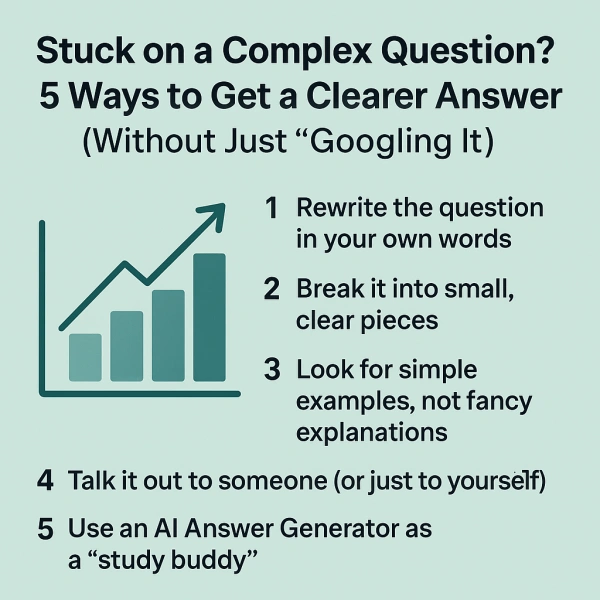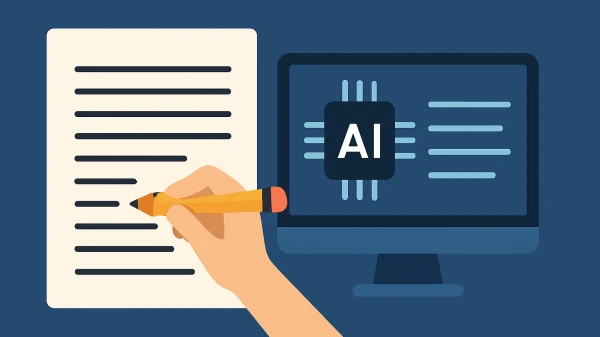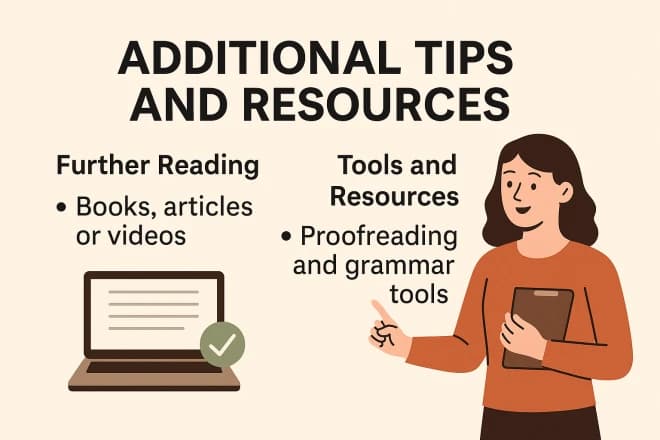Unlock Insights: Find the Answers You Seek on Our Blog
Stuck on a Complex Question? 5 Ways to Get a Clearer Answer
By Evelyn Sterling
Getting stuck on a complex question feels frustrating, but it usually has nothing to do with your ability. Most “hard” questions are simply written in a messy way—too long, too vague, or full of terms that slow you down. So you reread it, hoping it suddenly makes sense, and instead end up feeling even more confused.
If this sounds familiar, you’re not alone. Everyone hits this wall at some point, not because the topic is impossible, but because the question doesn’t give you a clear entry point. And without that, even simple ideas can feel out of reach.
The good news is that clarity can be created. With a few practical habits, you can take almost any confusing question and make it understandable.
In the next five sections, we’ll break down simple ways to do exactly that—no jargon, no tricks, just methods that actually help you think more clearly.

Way #1 – Rewrite the Question in Your Own Words
One of the most reliable ways to get unstuck is to restate the question in language that feels natural to you. Many “hard” questions only feel difficult because they’re wrapped in formal phrasing or extra information. When you rewrite them in plain, everyday words, the confusion often drops away.
Start by reducing the question to one short sentence. If you can’t do that, it usually means the original wording is cluttered—not that you don’t understand the topic. Keeping it simple forces you to see what the question is really asking.
As you rewrite, pay attention to the action words. They tell you exactly what kind of answer the question requires:
- Explain 🔍
- Compare ↔️
- Calculate ➗
- Why ❓
- How 🧭
Once you have a simpler version and a clear action, the question becomes less overwhelming. You’re no longer dealing with a wall of text—you’re dealing with a clear task. And with that clarity, you’re ready for the next step: breaking the question into smaller, manageable pieces.
Way #2 – Break It into Small, Clear Pieces
Most complex questions feel heavy because they’re trying to do too much at once. When a question mixes background information, instructions, and extra details into a single block, your mind doesn’t know where to land. Breaking it apart removes that tension.
1. Find the smaller questions inside the big one
Ask yourself:
“If I split this into separate steps, what would they be?”
Most “big questions” can be turned into 2–4 smaller ones.
Each one should feel simple enough to answer without thinking about the whole problem.
🟦 Example approach (no need to show real examples in your final article):
- What is happening here?
- What am I being asked to find or explain?
- What part depends on which?
2. Answer one piece at a time
Don’t try to hold everything in your head.
Just take the first small question and answer only that one.
Then move to the next.
This keeps your thinking clean. You’re not juggling multiple ideas—you’re solving one small part, then the next, until the bigger picture becomes obvious.
3. Let clarity build gradually
When each piece makes sense, the “big question” stops feeling big.
You understand what’s going on and what the answer requires.
And once you’ve broken the question down, the next natural step is to look for a simple example that helps the idea click—especially when the original wording still feels abstract.
Way #3 – Look for Simple Examples, Not Fancy Explanations
Sometimes the fastest path to understanding isn’t another explanation—it’s a simple example. Complex ideas often stay confusing because they remain abstract. When you translate them into something concrete, the meaning usually becomes obvious.
1. Create a basic, stripped-down example
Ask yourself:
“What’s the simplest version of this situation?”
It might be a tiny real-life scenario, a basic number, or a short story-like version.
The goal isn’t accuracy—it’s clarity.
🟦 Examples of formats you can use:
- “If this happened in everyday life, what would it look like?”
- “If I used very small numbers, how would this work?”
- “If this were a simple story, who would play each role?”
Simple examples work because they remove noise and highlight the core idea.
2. Use the example to spot what you’re missing
Once you have a straightforward example, compare it to the original question.
You’ll often notice:
- the specific part you didn’t understand
- the step you skipped
- the logic you assumed without realizing
This is the moment things start clicking into place.
3. Let the example guide your real answer
You’re not replacing the original question—you’re building a bridge to it.
When your simple example makes sense, you can walk back to the real problem with more confidence and a clearer view of what’s happening.
And once you’ve grounded the concept in something concrete, the next step is to test your understanding by explaining it out loud—even if no one is there to listen.
Way #4 – Talk It Out to Someone (or Just to Yourself)
Speaking your thoughts out loud is one of the most honest ways to check whether you understand something. You don’t need an actual listener—just saying the question and your rough idea of an answer in your own words can reveal things that silently rereading never will.
1. Say what the question is asking, as if you’re explaining it to a friend
Keep it casual and simple.
No academic tone, no “perfect answer” pressure.
Just: “This question is basically asking me to…”
If you can explain it cleanly, you probably understand the core of it.
If you can’t, that’s useful information—not failure.
2. Pay attention to where your voice hesitates
The moment you pause, ramble, or feel uncertain is the exact part you need to revisit.
That hesitation is a signal:
- a missing definition
- a step you can’t justify
- a concept that still feels fuzzy
- a link in the logic you can’t connect
Speaking turns those weak spots from vague feelings into something you can identify and fix.
3. Let talking become a tool, not a performance
This isn’t about sounding smart.
It’s about making your thinking visible to yourself.
And once your thoughts have some shape, you’re ready for the final step—using a structured tool to pull everything together and see the question from a clearer angle.
Way #5 – Use an AI Answer Generator as a “Study Buddy,” Not a Cheat
AI can be incredibly helpful when you’re stuck—not because it gives you the final answer, but because it helps you see the question more clearly. If you treat it like a study partner instead of a shortcut, it becomes a tool for understanding, not avoiding the work.
1. Ask the AI to simplify the question first
Paste the question in and request a short, simple version of it.
Something like:
“Can you rewrite this question in the most basic, beginner-friendly way?”
A clearer question is already half the solution.
2. Then ask for a short, plain explanation
Not a full essay. Not a perfect answer.
Just a quick, clean explanation of what the question is really about.
This helps you see the core idea without getting lost in details.
3. Request 1–2 examples or analogies
Examples make abstract ideas concrete.
Analogy makes them relatable.
Both give you a mental foothold—something to build on.
You can ask:
- “Show me a simple real-life example.”
- “Give me a beginner analogy.”
This isn’t cheating; it’s clarity-building.
4. Use AI insight to organize your own thinking, then write your answer yourself
The goal is not to copy what AI gives you.
The goal is to understand the structure—the steps, the logic, the pattern—so you can express it in your own words.
When AI becomes a guide instead of a replacement, you learn faster, stay honest, and keep full control over your work.
And with this final piece in place, you now have a full method for turning any confusing question into something you can actually understand and tackle with confidence.
Short Wrap-Up: Make the Question Simple First
When you’re facing a confusing question, the instinct is often to jump straight into finding the answer. But most of the time, that only makes you feel more stuck. The real first step is much simpler: make the question clear. Once the question makes sense, the answer becomes far more approachable.
Instead of guessing, circling back, or rereading the same sentence until it blurs, slow down and use the methods above. Rewrite the question in your own words. Break it into smaller parts. Build a simple example. Say your thoughts out loud. Each step removes a layer of confusion and gives your mind something solid to work with.
And when you still feel uncertain, using an AI Answer Generator can help you see the structure and core idea more quickly. Treat it like a study partner—one that explains things clearly but leaves the actual thinking to you.
With practice, these habits make hard questions feel far less intimidating. You’re not trying to “know everything”; you’re just giving yourself a clearer starting point.
Further reading
- Active Learning — Center for Teaching Innovation, Cornell University — Explains how students learn better by thinking, discussing, investigating and creating.
- Study shows students in ‘active learning’ classrooms learn more than they think — Harvard Gazette — Reports empirical evidence that “active learning” produces higher test scores than traditional lecture.
Author Bio
Matt Liu is the writer and product designer focused on helping people learn and think more clearly. He builds tools at AIFreeBox that support structured reasoning and reduce confusion, with a practical, human-first approach to using AI for everyday learning. His work combines experience in product research with a calm, simple way of explaining complex ideas.
AI Tools Categories
Browse all AI tools by category
All AI Tools
229Amazon
5AI Writing Generator
85Article & Content Writing
35Branding & Identity
54Content Generation
170Creative Ideas
32Educational Resources
34E-commerce
14Etsy
6Events & Celebrations
13Facebook
6Gaming & Fun
5Instagram
3Lifestyle & Personal
8LinkedIn
6Marketing & SEO
40Poem & Lyrics Writing
19Professional Documents
31Social Media
44Story & Book Writing
49Text Effects
14TikTok
7Twitter
3Writing Enhancement
36YouTube
11
Highly rated and most popular AI tools curated by our experts
Recently added AI tools that are gaining traction
- AI Post Generator

- AI Bullet Point Generator

- AI Discussion Post Generator

- AI 2 Weeks Notice Letter Generator

- AI Content Creation Ideas Generator

- AI Radio Ad Script Generator

- AI Podcast Script Generator

- AI Resume Objective Generator

- AI Resume Headline Generator

- AI Password Generator

- AI Snapchat Caption Generator

- AI Snapchat Username Generator

- AI Pinterest Board Name Generator

- AI LinkedIn Experience Description Generator

- AI Twitter Hashtag Generator

- AI YouTube Short Idea Generator

we prioritize displaying the latest content closely related to the current blog post.







